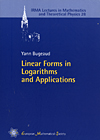- About MAA
- Membership
- MAA Publications
- Periodicals
- Blogs
- MAA Book Series
- MAA Press (an imprint of the AMS)
- MAA Notes
- MAA Reviews
- Mathematical Communication
- Information for Libraries
- Author Resources
- Advertise with MAA
- Meetings
- Competitions
- Programs
- Communities
- MAA Sections
- SIGMAA
- MAA Connect
- Students
- MAA Awards
- Awards Booklets
- Writing Awards
- Teaching Awards
- Service Awards
- Research Awards
- Lecture Awards
- Putnam Competition Individual and Team Winners
- D. E. Shaw Group AMC 8 Awards & Certificates
- Maryam Mirzakhani AMC 10 A Awards & Certificates
- Two Sigma AMC 10 B Awards & Certificates
- Jane Street AMC 12 A Awards & Certificates
- Akamai AMC 12 B Awards & Certificates
- High School Teachers
- News
You are here
Linear Forms in Logarithms and Applications

Publisher:
European Mathematical Society
Publication Date:
2018
Number of Pages:
224
Format:
Paperback
Series:
IRMA Lectures in Mathematics and Theoretical Physics 28
Price:
48.00
ISBN:
9783037191835
Category:
Monograph
[Reviewed by , on ]
Allen Stenger
09/18/2018
The subject matter of this book is linear forms in logarithms: that is, combinations of the form \[\beta_0 + \beta_1 \log \alpha_1 + \dots + \beta_n \log \alpha_n \] where the \(\alpha_i\) are given non-zero algebraic numbers and the \(\beta_i\) are variables. It was proved by Alan Baker in the 1960s that if the \(\log \alpha_i\) are linearly independent over the rationals (that is, this form is non-zero whenever the \(\beta_i\) are rationals, not all zero) then they are also linearly independent over the algebraic numbers (the form is non-zero whenever the \(\beta_i\) are algebraic, not all zero). The book is then concerned with establishing lower bounds for the absolute value of this form, especially effective bounds. Most of the book is concerned with applications of these lower bounds, of which there are many diverse ones in number theory.
The forms first came up in the theory of transcendental numbers. The Gelfond–Schneider theorem from 1934 states that if \(\alpha\) is an algebraic number other than \(0\) and \(1\) and \(\beta\) is irrational, then \(\alpha^\beta\) is transcendental. This is a lightly-disguised version of the special case \(\beta_0=0\), \(n = 2\)
Today many of the applications are in Diophantine equations. The author remarks on p. 13 that “Many Diophantine problems can be reduced to lower bounds for linear forms in two or three logarithms.” The two-logarithm bounds are very well developed, and chances are that a Diophantine problem can be solved if it can be put in this form; the three-logarithm cases are not as well-understood. The lower bound gives a way to limit the size of the variables in the Diophantine equation, which means there are at most finitely many solutions, and if the lower bound is effective we may be able to give explicit bounds on the variables and then solve the problem completely by inspection of small cases. One example is the Catalan conjecture that 8 and 9 are the only consecutive perfect powers, in other words, that \(x^m - y^n = 1\) has only the solution \(3^2 - 2^3 = 1\). Tijdeman proved in 1976 using linear forms that there were only finitely many solutions, and Mihailescu proved in 2002 that there was only one solution.
The book covers applications in many other areas besides Diophantine equations, including the largest prime factor in various sequences, the \(abc\)-conjecture, and estimates on the height of algebraic numbers. There’s also a chapter on the analogous theory of linear forms in \(p\)-adic logarithms, and a final chapter of open problems. There are a few exercises at the chapter ends.
The present book is more tutorial than definitive; it states and proves results that are accessible and useful, but not the best possible, and it refers the reader to the original papers to get the best possible results.
An earlier book (referred to frequently in this one) with a lot of overlap is A Panorama of Number Theory or: The View From Baker’s Garden (ed. Gisbert Wüstholz, Cambridge, 2002).
Allen Stenger is a math hobbyist and retired software developer. He is an editor of the Missouri Journal of Mathematical Sciences. His personal web page is allenstenger.com. His mathematical interests are number theory and classical analysis.
See the table of contents in pdf format.
- Log in to post comments




